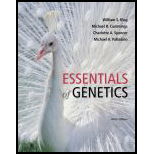
Concept explainers
CASE STUDY | Art inspires learning
A genetics student visiting a museum saw a painting by Goya showing a woman with a newborn baby in her lap that had very short arms and legs along with some facial abnormalities. Wondering whether this condition might be a genetic disorder, the student went online, learning that the baby might have Roberts syndrome (RBS), a rare autosomal recessive trait. She read that cells in RBS have mitotic errors, including the premature separation of centromeres and other heterochromatic regions of homologs in metaphase instead of anaphase. As a result, metaphase chromosomes have a rigid or “railroad track” appearance. RBS has been shown to be caused by mutant alleles of the ESCO2 gene, which functions during cell division.
The student wrote a list of questions to investigate in an attempt to better understand this condition. How would you answer these questions?
What do centromeres and other heterochromatic regions have in common that might cause this appearance?
Case summary:
On visiting the museum, the genetics student noticed a painting made by the Goya. In the painting, a woman was drawn with the baby in her lap, the baby had very little arms and legs along with some facial abnormalities. The student wonders about the condition, that it might be a genetic disorder. Through the online research, he reached to the conclusion that the baby might have RBS (Roberts syndrome), it is a rare autosomal recessive trait. In this disorder, the cells suffered from the mitotic errors that include the early separation of the centromeres and also heterochromatic regions of the homologous chromosomes at the stage of the metaphase instead of anaphase. RBS is caused by the mutated alleles of the ESCO2 gene, that has a role in the cell division.
Characters in the case:
A genetics student and a painting of a baby withvery little arms and legs along with some facial abnormalities.
Adequate information:
Facts of the case that brings in major impact are the limbs and facial abnormality in the painting of a baby, which a genetic student interpreted as RBS (Roberts syndrome) that iscaused by the mutated alleles of the ESCO2 gene.
To determine:
The common thing in between the centromere and other heterochromatic regions that causes the abnormal appearance in the RBS.
Given information:
The newborn baby had many facial abnormalities and also the length of the arms and legs are comparatively short.
Explanation of Solution
Roberts syndrome is the extremely rare genetic disorder that is due to the disrupted cell division that leads to the malformation of the bones, face, arms, legs and the skull. On chromosome number 8, a mutation in the gene ESCO2 results in the Roberts syndrome.
In a normal individual, during the cell division the copied chromosomes attach themselves to the centromeres but in RBS the newly formed chromosomes are not frequently attached themselves with the centromeres. Due to which the proper alignment of the chromosomes does not takes place.
PCS (premature chromosomal separation) occurs in the RBS as the chromosomes that are supposed to separate at the anaphase stage separates at the metaphase stage. Another chromosomal abnormality is that HR (heterochromatin repulsion), chromosomes that are having the HR experiences the heterochromatin separation at the metaphase stage. Both of these chromosomal abnormalities displays a railroad track appearance as they both lack the primary constriction and also the heterochromatin repulsion.
Therefore, it can be concluded that centromeres and the other heterochromatin regions both are separated at the metaphase stage that could cause the abnormality in the baby having RBS.
Want to see more full solutions like this?
Chapter 11 Solutions
Essentials of Genetics (9th Edition) - Standalone book
- What is behavioral adaptarrow_forward22. Which of the following mutant proteins is expected to have a dominant negative effect when over- expressed in normal cells? a. mutant PI3-kinase that lacks the SH2 domain but retains the kinase function b. mutant Grb2 protein that cannot bind to RTK c. mutant RTK that lacks the extracellular domain d. mutant PDK that has the PH domain but lost the kinase function e. all of the abovearrow_forwardWhat is the label ?arrow_forward
- Can you described the image? Can you explain the question as well their answer and how to get to an answer to an problem like this?arrow_forwardglg 112 mid unit assignment Identifying melting processesarrow_forwardGive only the mode of inheritance consistent with all three pedigrees and only two reasons that support this, nothing more, (it shouldn't take too long)arrow_forward
- Oarrow_forwardDescribe the principle of homeostasis.arrow_forwardExplain how the hormones of the glands listed below travel around the body to target organs and tissues : Pituitary gland Hypothalamus Thyroid Parathyroid Adrenal Pineal Pancreas(islets of langerhans) Gonads (testes and ovaries) Placentaarrow_forward
 Human Heredity: Principles and Issues (MindTap Co...BiologyISBN:9781305251052Author:Michael CummingsPublisher:Cengage Learning
Human Heredity: Principles and Issues (MindTap Co...BiologyISBN:9781305251052Author:Michael CummingsPublisher:Cengage Learning Biology: The Dynamic Science (MindTap Course List)BiologyISBN:9781305389892Author:Peter J. Russell, Paul E. Hertz, Beverly McMillanPublisher:Cengage Learning
Biology: The Dynamic Science (MindTap Course List)BiologyISBN:9781305389892Author:Peter J. Russell, Paul E. Hertz, Beverly McMillanPublisher:Cengage Learning Biology: The Unity and Diversity of Life (MindTap...BiologyISBN:9781305073951Author:Cecie Starr, Ralph Taggart, Christine Evers, Lisa StarrPublisher:Cengage Learning
Biology: The Unity and Diversity of Life (MindTap...BiologyISBN:9781305073951Author:Cecie Starr, Ralph Taggart, Christine Evers, Lisa StarrPublisher:Cengage Learning Biology 2eBiologyISBN:9781947172517Author:Matthew Douglas, Jung Choi, Mary Ann ClarkPublisher:OpenStax
Biology 2eBiologyISBN:9781947172517Author:Matthew Douglas, Jung Choi, Mary Ann ClarkPublisher:OpenStax Biology: The Unity and Diversity of Life (MindTap...BiologyISBN:9781337408332Author:Cecie Starr, Ralph Taggart, Christine Evers, Lisa StarrPublisher:Cengage Learning
Biology: The Unity and Diversity of Life (MindTap...BiologyISBN:9781337408332Author:Cecie Starr, Ralph Taggart, Christine Evers, Lisa StarrPublisher:Cengage Learning Biology (MindTap Course List)BiologyISBN:9781337392938Author:Eldra Solomon, Charles Martin, Diana W. Martin, Linda R. BergPublisher:Cengage Learning
Biology (MindTap Course List)BiologyISBN:9781337392938Author:Eldra Solomon, Charles Martin, Diana W. Martin, Linda R. BergPublisher:Cengage Learning





